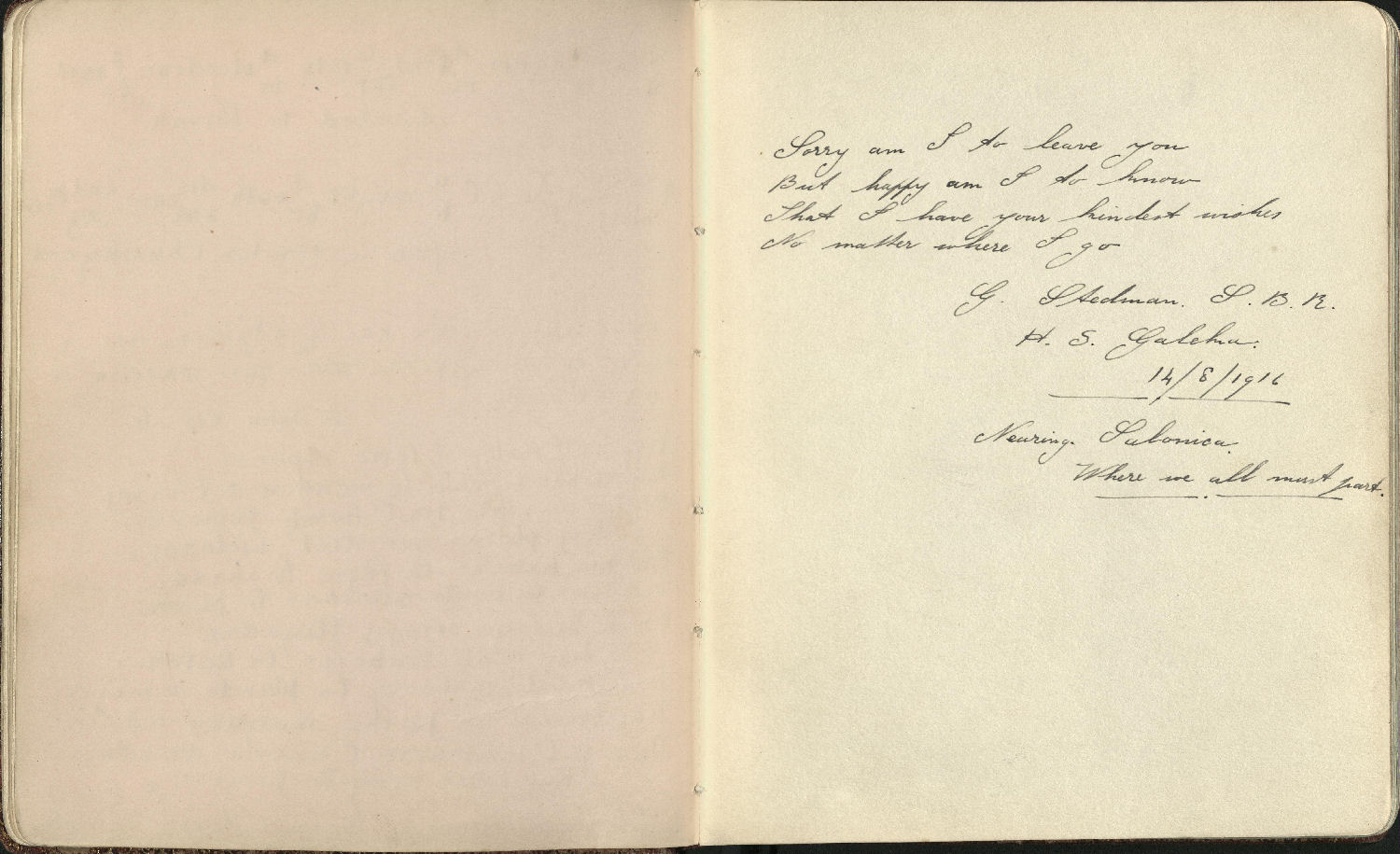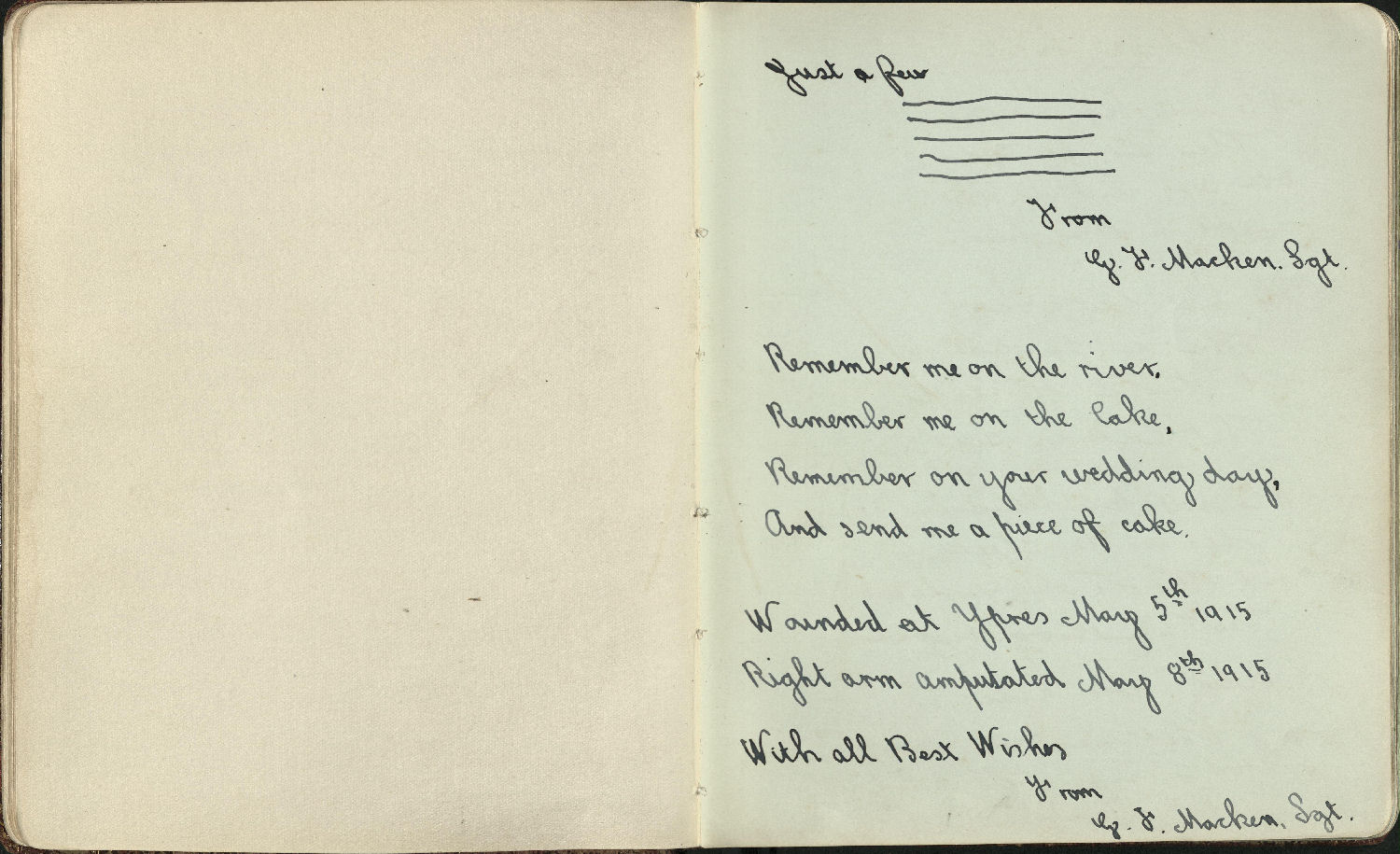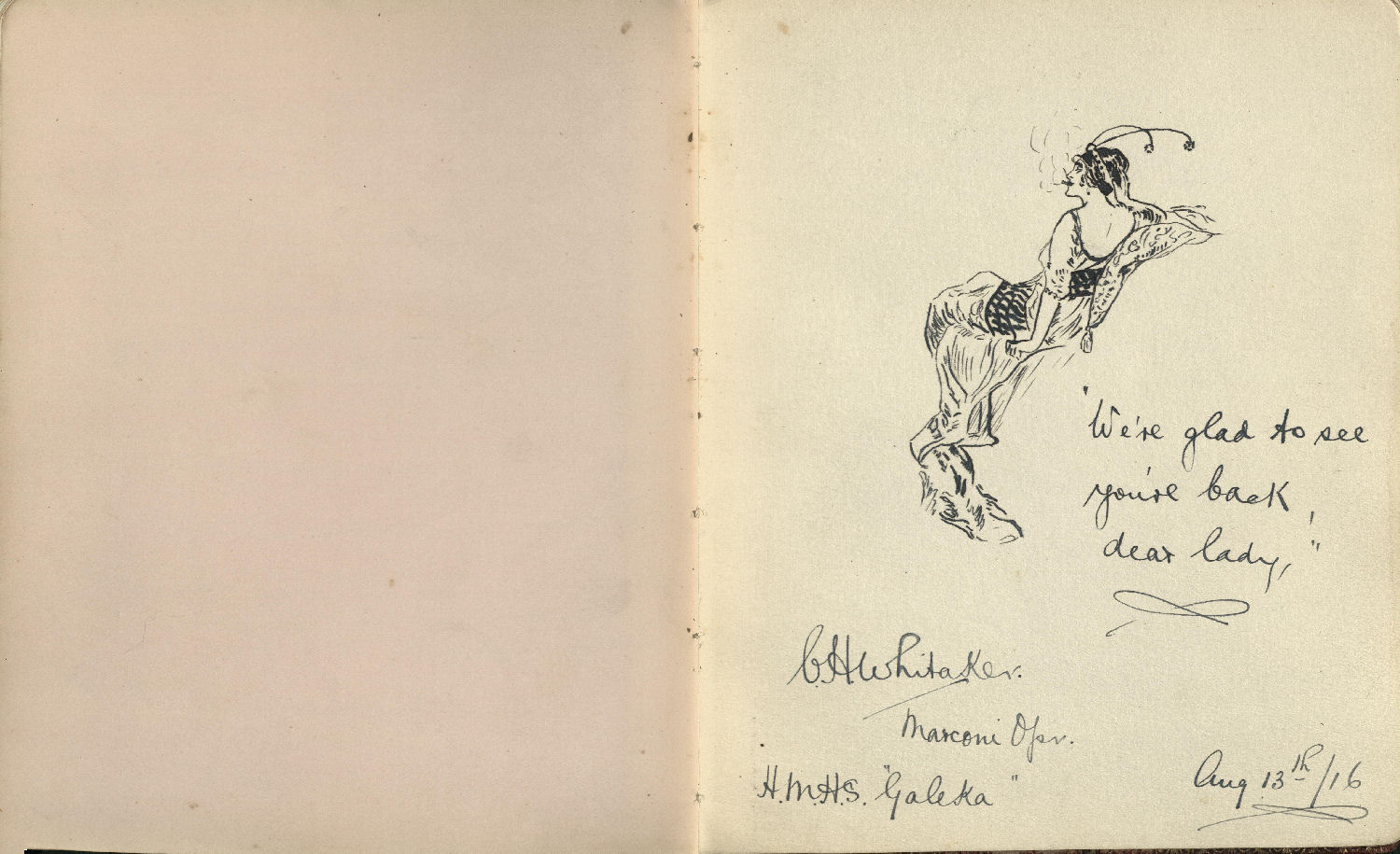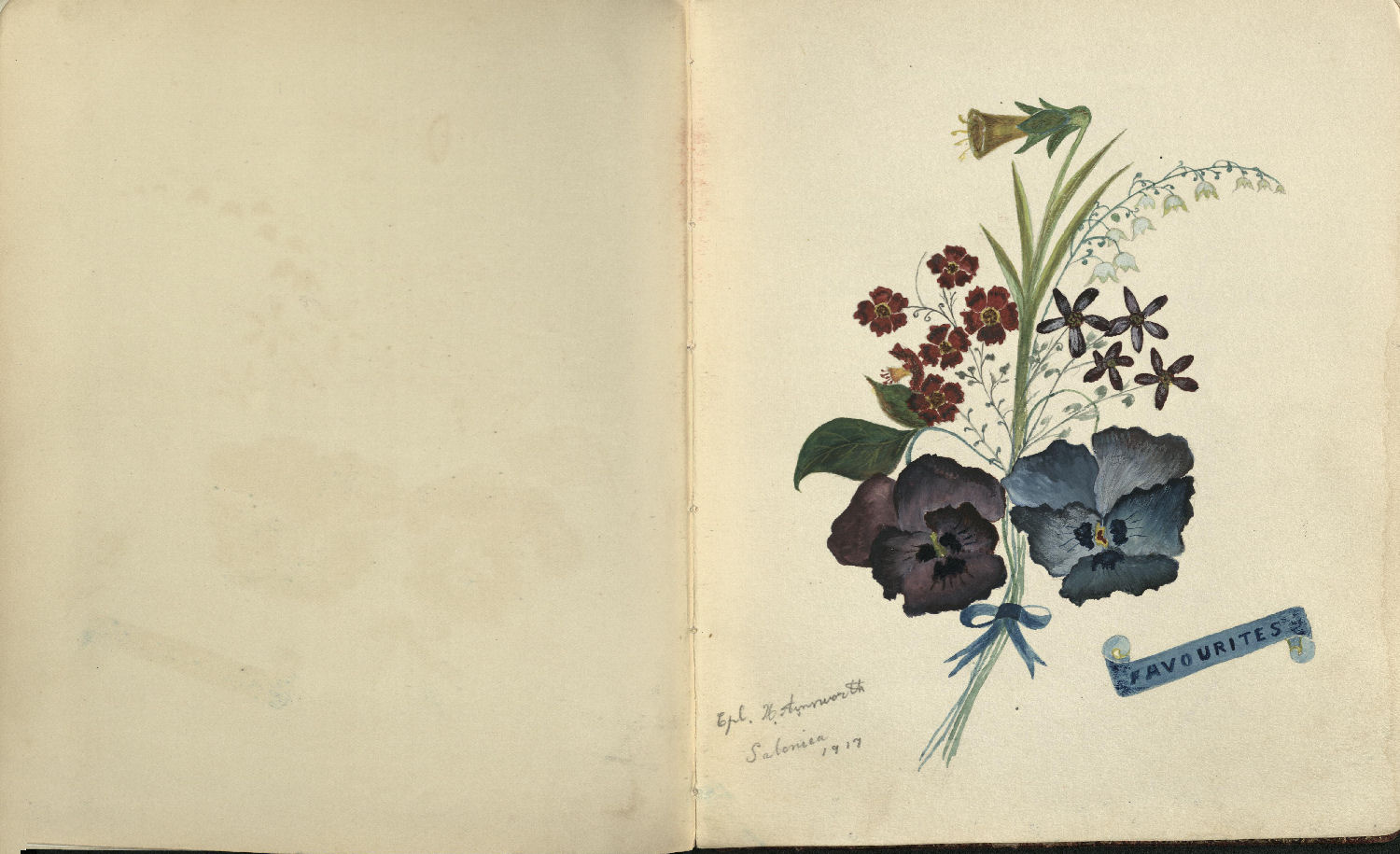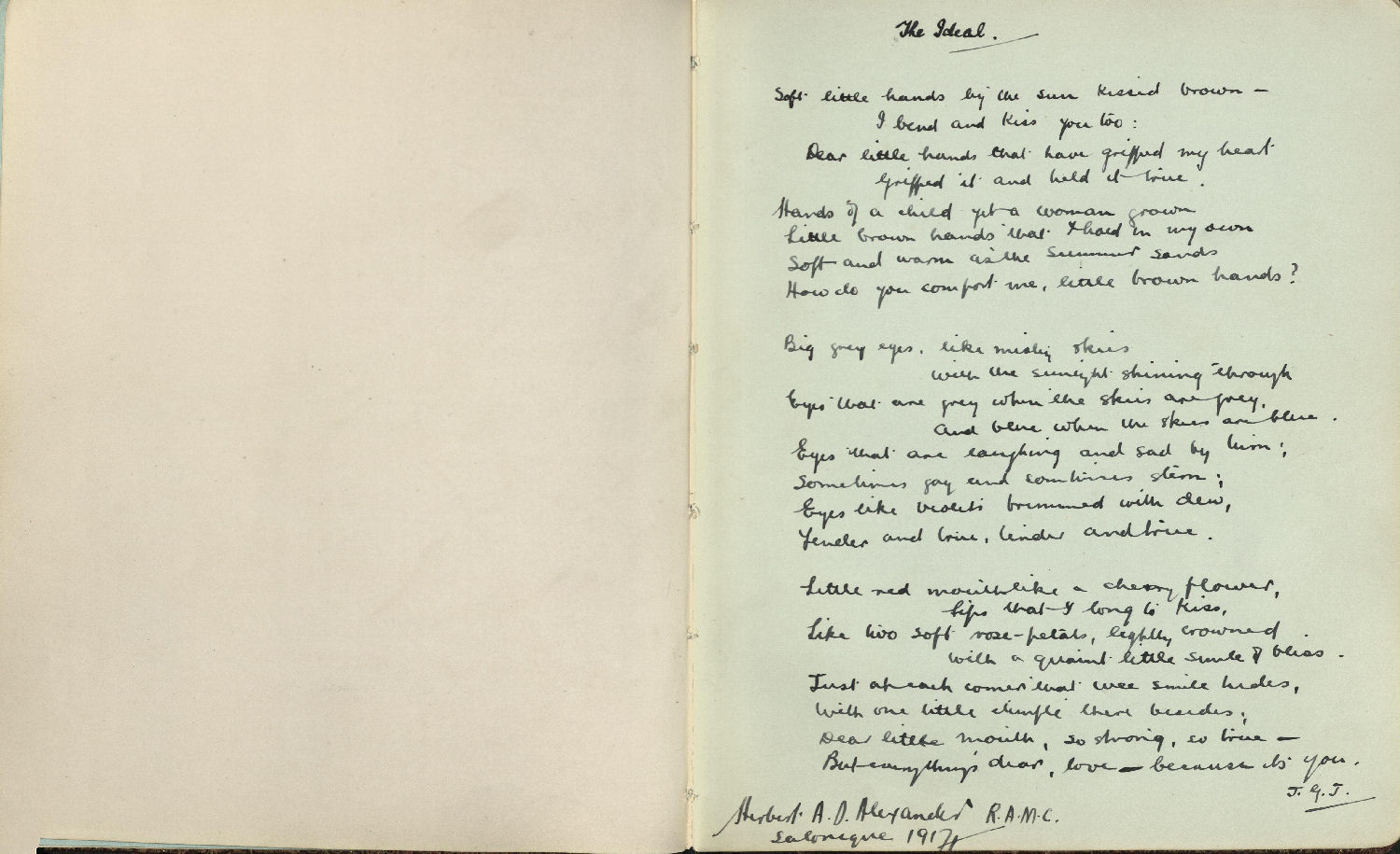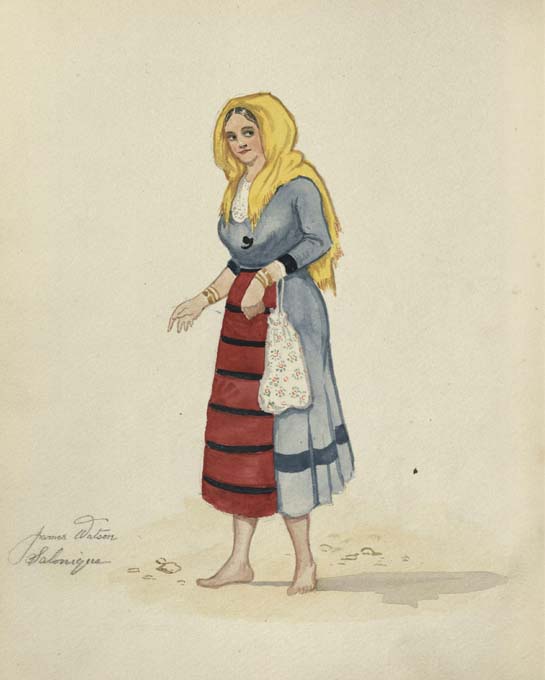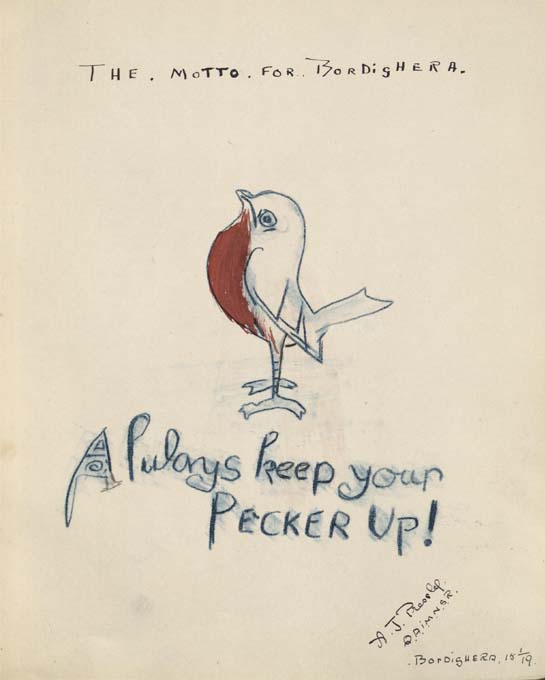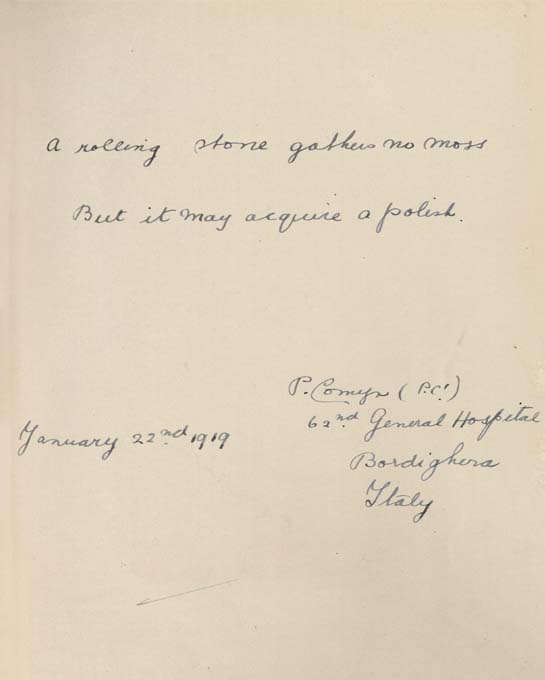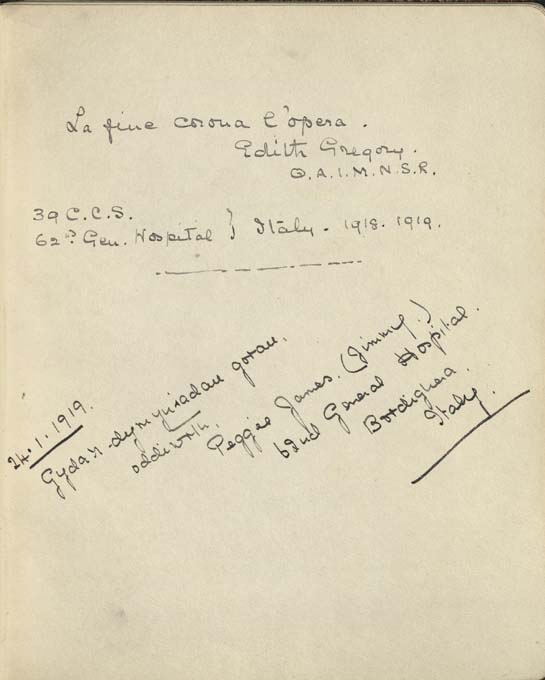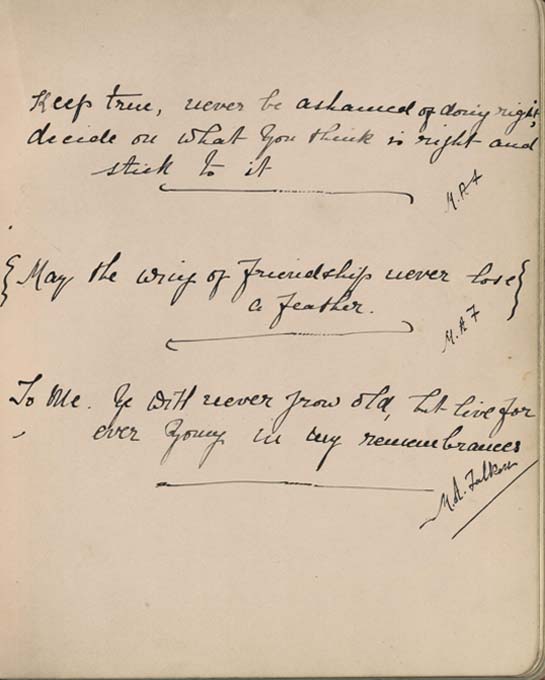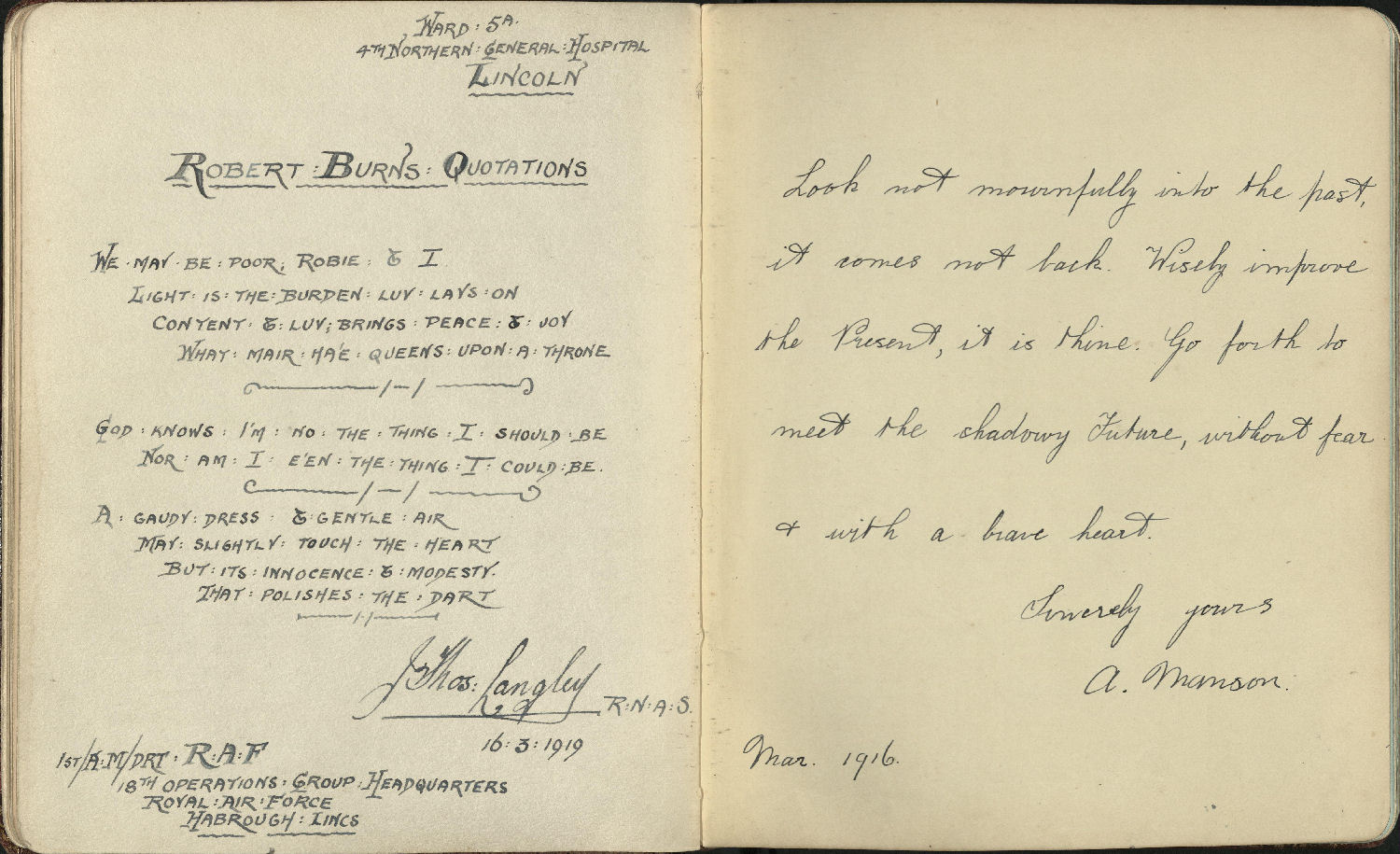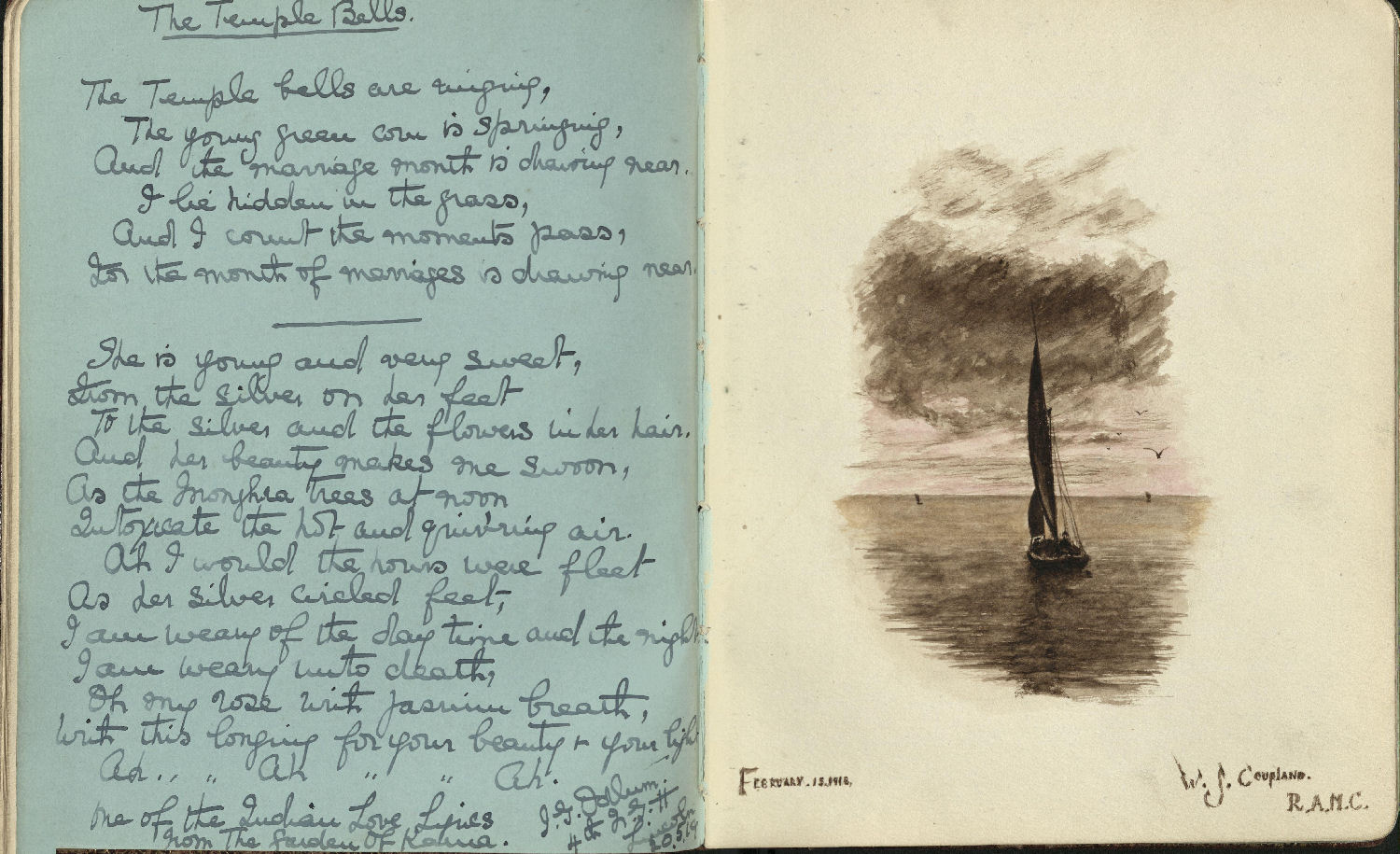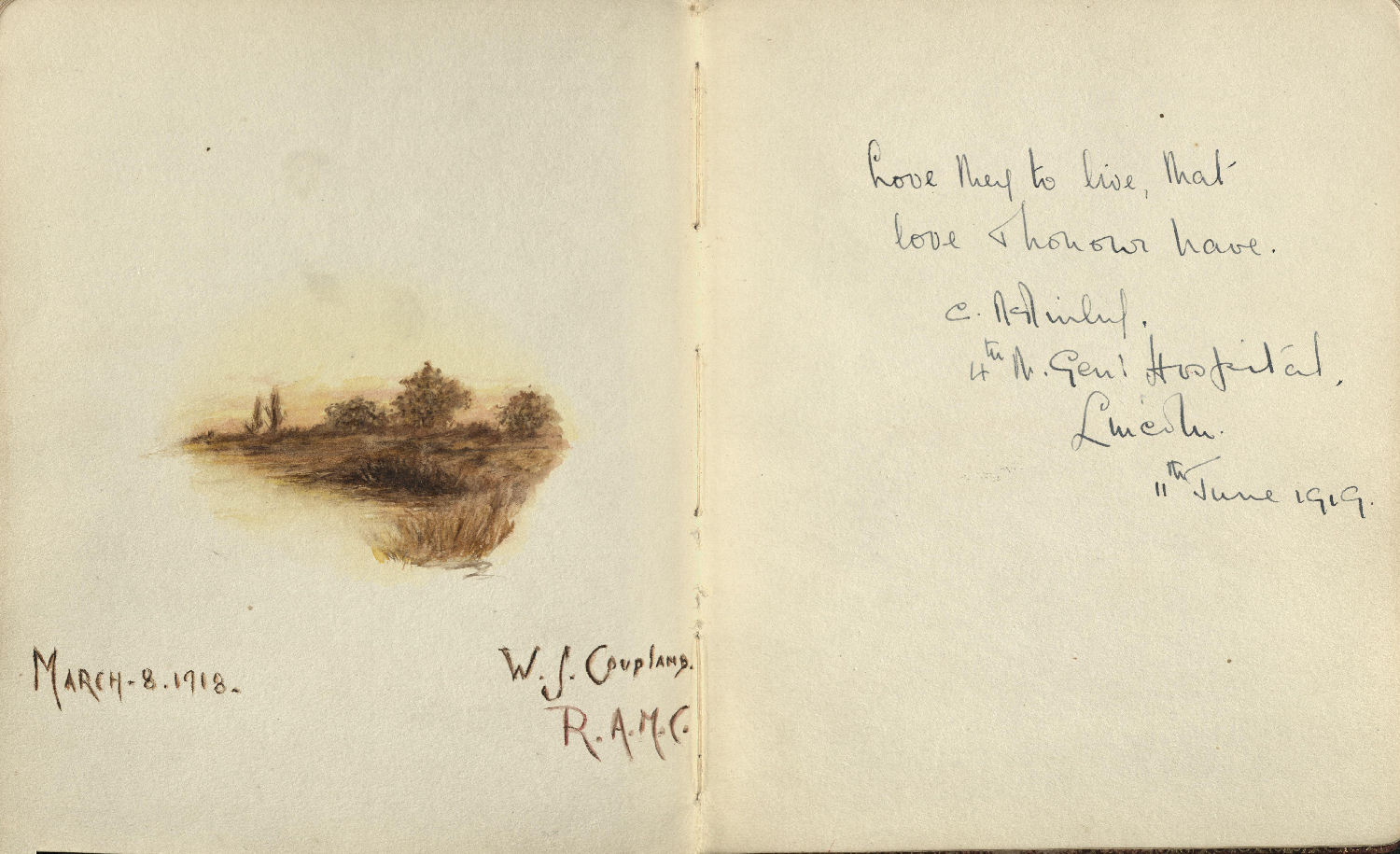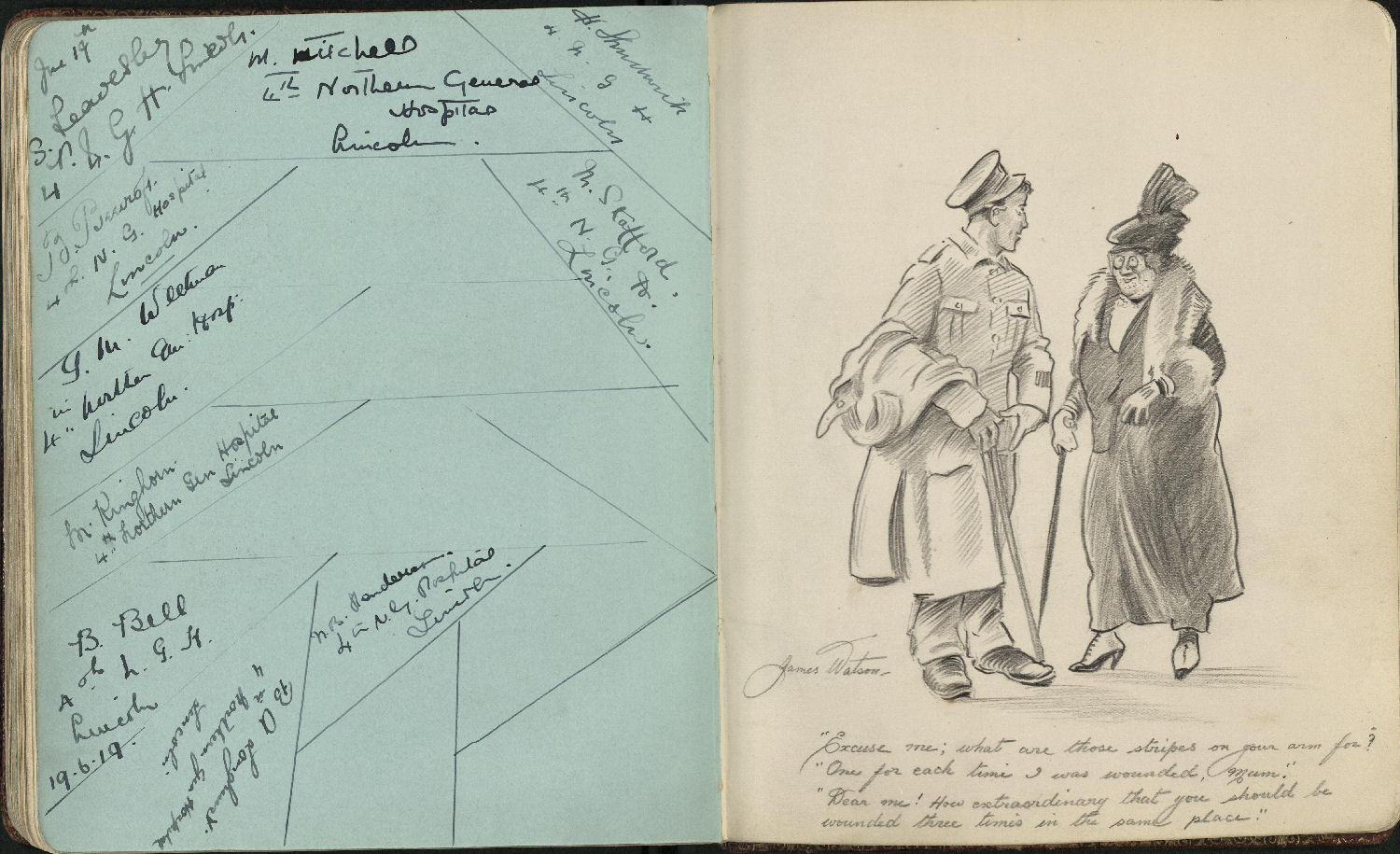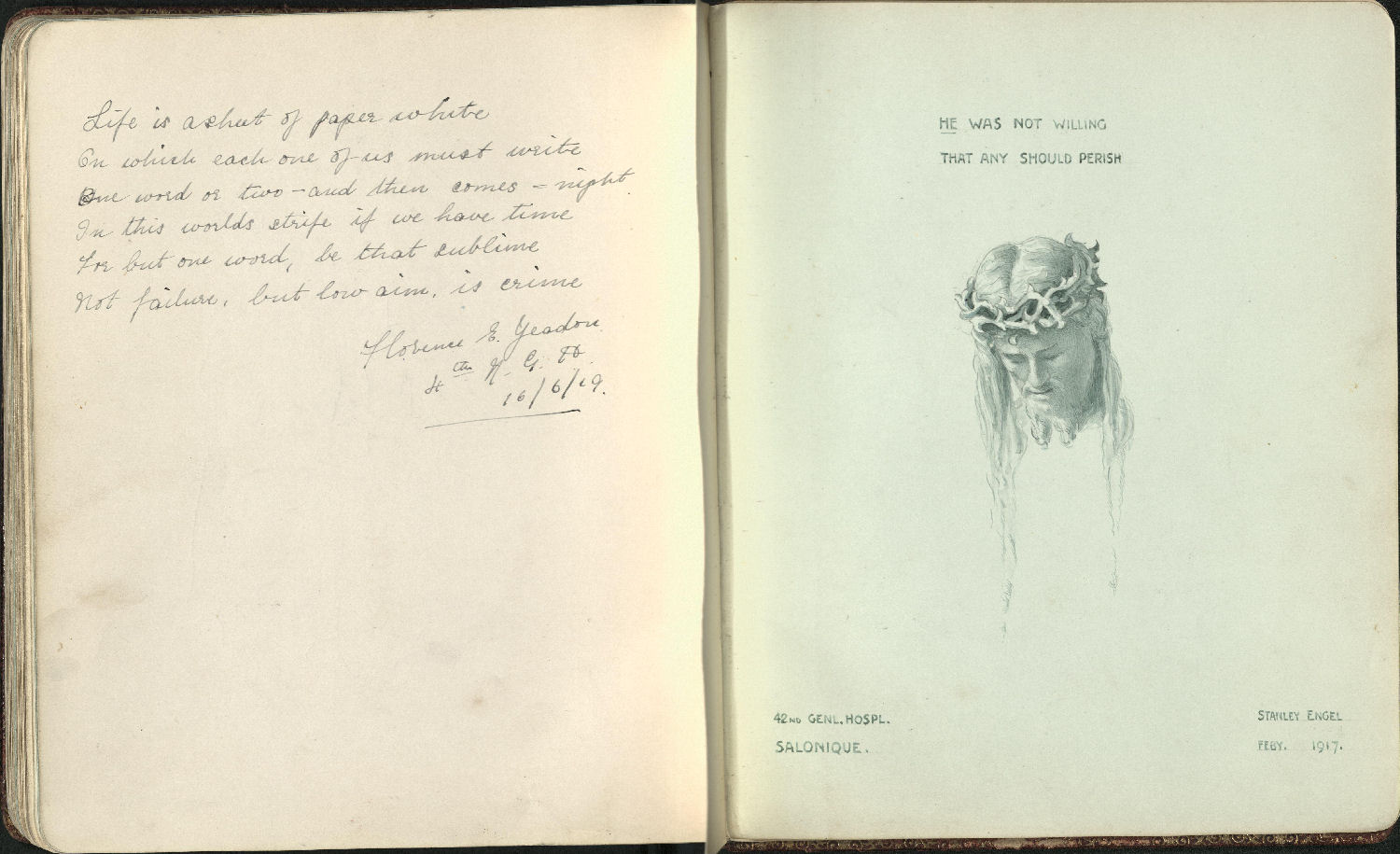Mabel Pearce
"You will do almost anything – kill you or cure for this lady who treats you so sweetly."
Early career
Pearce started her nursing career in Worcester General Infirmary, training there from 1908-1911. Whilst here she would have lived and attended lectures in the relatively new Nurses Home. After her three years' training, Pearce could join the Territorial Force Nursing Service. To join you needed to have at least three years training at a recognised infirmary, unmarried, and be over the age of 23. Fully trained, single and aged 27, Pearce qualified. As a member of TFNS Pearce would be a reserve and continue to work in a civilian hospital during peacetime. TFNS nurses could be identified by the silver 'T' badges worn in the corner of their tippets. If you look at Pearce's photo you can see her distinctive badges.
She first wrote in her scrapbook on the 10th March 1914, a few months before the beginning of the First World War. Possibly it was gifted it to her by Joseph Cliff who wrote in the book on the same day. A few months later, on the 4th of August, war was declared. The entry for the day after encourages Pearce to 'cheer up, be happy.'

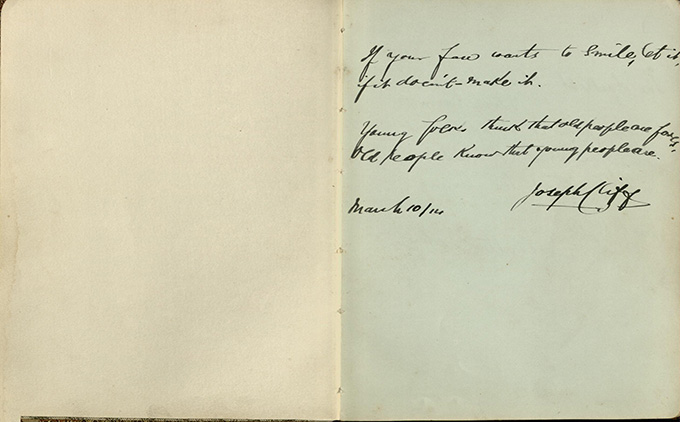
Family
Pearce had a twin brother, William Pearce, who was also involved in the war effort. Here, you can see them both together in an undated portrait. Clearly William has signed up to fight. Similarly, in her TFNS uniform Pearce is indicating her involvement in the war. Studio portraits such as these were commonly taken before heading off to fight for the first time. It is likely that William was about to leave for war. This image would be sent to family and friends, possibly as a postcard. William survived the war, although we have no information about his time in combat.


Images: Pearce in TFNS uniform. From the RCN archive, C186/P/22/1/44
Pearce, with her twin brother William. From the RCN archive, Ref. No. C186/P/22/1/45
Lincoln
As a member of TFNS Pearce was posted to a military hospital. By 1916 Pearce was in the 4th Northern General Hospital, Lincoln, a converted boys' school. It held 1,167 beds. Extra tents were placed in the grounds to provide more room with ten beds in each. For every 50 beds there was one sister, two nurses and two Voluntary Aid Detachments (VADs). The soldiers arrived in Lincoln straight from clearing stations on the front line. VAD Caroline Maud Edgley, who worked in the 4th General at the same time as Pearce, recalls having to peel the clothes off men who had been wearing them for up to six weeks on the front line. She remembered the main reasons for admission to the hospital as shrapnel wounds, tuberculosis, malaria and jaundice.
Fellow TNFS member Sullivan-Crooke writes the patients are;
British, Belgian, Flemish & French
Men who've experienced life in a trench,
Sick or wounded in body or mind.
Those Pearce tended therefore weren't solely British soldiers. Another patient signs his name and leave his address as Toronto.
Whilst working here the nurses and VADs were billeted into local houses, each of which had a sister in charge of them. In the hospital the patients were encouraged to engage in hobbies, there was a recreation centre and gardens outside the huts where patients grew plants and vegetables. Prizes were even given for the best-kept garden.
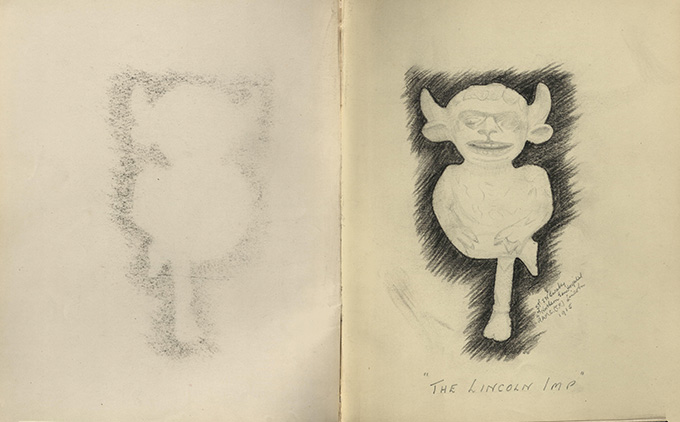
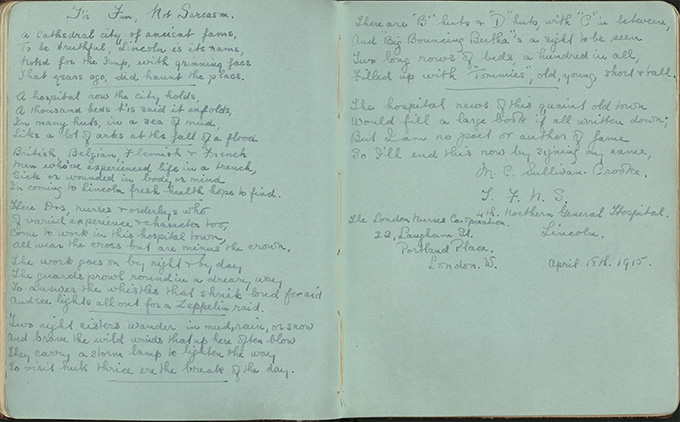
Two night sisters wander in mud, rain, or snow
And brave the wild winds that up here often blow
They carry a storm lamp to lighten the way
To visit huts thrice ere the break of the day.
Poems from patients
The entries in her scrapbook show that whilst here she was not short of grateful patients. A few of them even took the opportunity to pen poems in her honour. One poem describes her as 'radiant and smiling' another 'bright and smiling'. Pearce's interactions with her patients seem to have been overwhelmingly positive. It sounds like quite a few of them may have tried to develop a further relationship with her. Here, one soldier jokingly writes of his rejection;
Mabel, love Mabel, What must one pay? "Good stranger, the market's Not open today."
Perhaps Pearce was one of the many nurses Edgley recalls being popular with the patients for bringing them cakes and sweets.
Some patients choose instead to focus on their experiences in the war:
For brave deeds & doing you get the V.C.
To be worn on the left breast so that all may see
But there’s thousands of brave lads &
Thousands to be,
Whose reward for brave deeds is just R.I.P.
This is one of the few entries in Pearce's scrapbook to focus on the distress experienced in war. Most of the others tend to focus on their positive experience with Pearce, or leave her encouraging messages. There is an earnestness to this entry, as if the soldier has stopped any pretence they find the war worth dying for. Once recovered, many of these soldiers would have been sent back to fight again.

Sister Elsie Dakin writes Pearce a poem to summarise their time in Lincoln. She speaks of how the 'the streets are red with tippets'. Clearly the city had been overtaken by the activities of the large military hospital, which treated 45,000 men throughout the war. There were also two auxiliary hospitals near Lincoln. Although a lot smaller, they would have contributed to the overall feeling the city was dominated by hospital activity. Asking how much longer they would stay there, Dakin's poem seems to come at the end of a long stint at the hospital. 'We've a very happy time’ she insists 'but if we stay here another year, we deserve the R.R.C' (Royal Red Cross). Pearce's time at Lincoln was about to end and in August of 1916 she was transferred to Salonica. Those in the 4th General were sad to see her go, one entry from July reads 'With never to be forgotten gratitude for helpful sympathy in my life's greatest trial.' Pearce would clearly be leaving behind a lot of grateful patients in Lincoln.

Soldier's kit bag
A bayonet
A steel Brodie helmet
Ammunition pouches for bullets and possibly grenades
An anti-gas hood
Enfield rifle
The typical soldier’s kit bag weighed 27kg and contained everything he would need for the front – from shovels to letters from home.
Puttees leg wraps (worn from ankle to knee) by most armies at this time

"It's a Long, Long Way to Tipperary"
In this image a crying soldier is captioned with 'It's a Long, Long Way to Tipperary.', which refers to the title of a song popularised in the First World War. Reputedly a favourite amongst the British soldiers, it was sang as they marched through France. As the illustration indicates, 'Tipperary' has a sorrowful tone. The focus on longing for home sets it apart from previous war songs, which were normally about bravado and victory.
A soldier crying is an unusual theme for a painting. It matches the unorthodox popularity of 'Tipperary'. The theme of sadness and distress in both illustrates how badly affected the soldiers fighting in the war were. So far we have been unable to identify the exact regiment of the crying soldier. Perhaps he represents the average British private?
H.M.H.S. Galeka
Entries in the scrapbook indicate that Pearce spent some time aboard the H.M.H.S. Galeka, a hospital ship. Through the entries we can trace the course of the ship. On the 10th of August 1916 they were nearing Malta, by the 13th they were on the Aegean Sea, and on the 14th they had reached Salonika. Whilst on board Pearce proved to be popular with the patients once again, with G. Steadman signing:
'Sorry am I to leave you
But happy am I to know
That I have your kindest wishes
No matter where I go'.
Pearce was popular with the staff too, the chief steward Arthur Austin wishing 'May good health and good fortune always attend you.' This was one of the last trips the H.M.H.S. Galeka would take. In October that year she hit a mine, killing nineteen Royal Army Medical Corps personnel, most likely some of whom Pearce would have known from her time aboard.
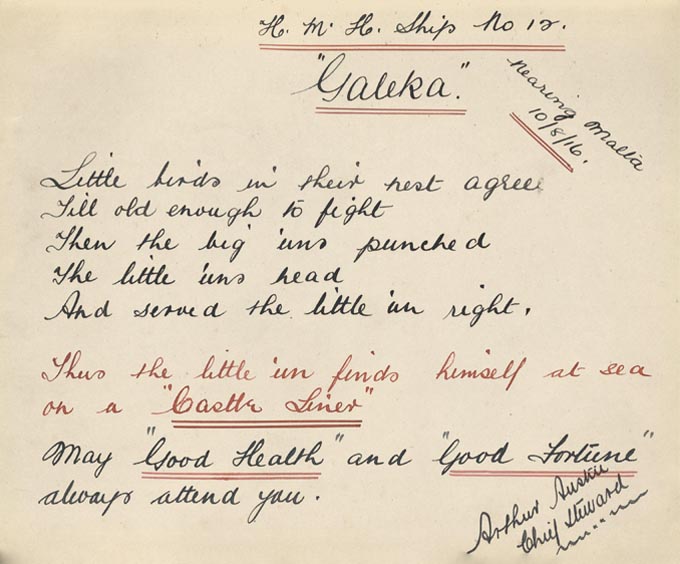

Horrid medicines you drink: nasty pains you endure
As she does all so nicely and neatly
You will do almost anything – kill you or cure
For this lady who treats you so sweetly.
Salonica
Pearce was posted in the 48th General Hospital, Salonica. Here she continued to earn her patients' affections. Fergus Ferguson illustrates the extra effort Pearce would put in with her patients, saying;
who taught me how to sew and darn,
and knit and stitch and spin this yarn
and quite forget Mons and the Marne
T’was Mabel- Mabel Pearce
Pearce's measures to ensure her patients were kept occupied – with sewing, poetry or the drawings we can see in her scrapbook – show her understanding of how detrimental boredom in a hospital could be to a recovering soldier. In doing these extra activities she was allowing the soldiers to forget, however briefly, the reason they were in the hospital. If Ferguson could 'quite forget the Mons and the Marne' – two very intensive battles of 1914 – then Pearce was doing a very good job indeed. Spending so much extra time with the patients can surely account for much of their admiration for her. A rather more straightforward account of her time here comes from her report, which states 'professional ability satisfactory, ward work – good'. Although by no means a glowing and personal report, Pearce's competence as a nurse is apparent.
The Red Cross Nurse's costume,
Is a thing all Soldiers adore;
And the dainty Maiden wearer.
Makes it sweeter, than before
As in Lincoln, in Salonica Pearce gained admiration for more than just her nursing ability. One member of the R.A.M.C. writes;
Little red mouth like a cherry flower, Lips that I long to kiss, Like two soft rose-petals, lightly crowned with a quaint little smile of bliss.
Unfortunately, we do not know how Pearce responded to these declarations.
Auld Scotland is better in every way.
B. I. Ryrie.
Salonica 8:6:17.
Probably written when he was fedup
And wantin' home.

62nd General Hospital, Bordighera
Her time in Bordinghera is summarised with a far more enthusiastic report in which she is described as 'good tempered, energetic, tactful, punctual with good ability to instruct' in short, everything her patients were writing about her in the scrapbook.
Not all nurses seem to be a favourite like Pearce. You can see one particularly cheeky patient drew an angry-looking sister overseeing 'Smith' scrubbing the floors. From her rank and Red Cross uniform, we can tell this wasn't based on Pearce. Perhaps it depicts a sister both her and the artist knew? From the illustration she does not seem to have fostered the admiration Pearce gained.
In her report Pearce was described as a 'capable medical and surgical nurse' indicating that in Bordinghera, at least, she was a surgical nurse. During the war nurses increasingly performed minor surgery themselves, along with pinching and stitching up wounds. As a 'capable' surgical nurse it is likely Pearce would have carried out these tasks.
When the war ended in November 1918, Pearce continued at her post in Bordinghera. She stayed here until at least January 1919. Two scrapbook entries at this time imply that she may have been leaving, as they contain positive encouragements about the future.
Self reliant, with good powers of initiative and administration.
Had on several occasions undertaken Sisters duties with good ward management.
As old Mother Terrier said to her pup,
"In all life’s adversities, keep your tail up."
A. Clark
After the war
After the war Pearce was entitled to the British war medal as she had served overseas and the Victory medal which was given to all who served during the First World War. Due to her four years' good service she was allowed to keep her TFNS badge. Some with less service would have had to return it. The testimonial from Matron in Chief Sidney Brown highlights Pearce's good service during the war.
Work has been excellent and appreciated by all those you have served under.
This final comment, combined with the countless in the scrapbook, provide us with a picture of what an exceptional nurse Pearce was, and how important her work was during the war.
Apparently not one to rest, from a few scrapbook entries we can see Pearce had returned to 4th General Lincoln Hospital by March 1919.
Pearce eventually moved from Lincoln to Sussex. Here she carried on nursing, whilst also continuing to be a member of TFNS. In 1921 TFNS became the became the Territorial Army Nursing Service (TANS). In 1929, Pearce was promoted to a Sister in TANS. She would hold this position for eight years until she resigned in 1937.
Pearce died in September 1976.
References
Adams, J., Bowsher, C., Learning to Care. www.historywm.com/articles/learning-to-care [accessed 6 April 2018].
Allen, T., (2015). SS Galeka. Available at: https://www.wrecksite.eu/wreck.aspx?12561 [accessed 6 April 2018].
Edgley, C. M., interviewed by Margaret A. Brooks, (1975). Imperial War Museum. Available at: www.iwm.org.uk/collections/item/object/80000511 [accessed 6 April 2018].
Harrod, P., (2018) Life at the 4th Northern General Hospital during the Great War. Available at: www.christs-hospital.lincs.sch.uk/our-school/lchs-history/school-archive/176-occasional-paper-no-35-life-at-the-4th-northern-general-hospital-during-the-great-war [accessed 6 April 2018].
Light, S. (2018). TF Nursing Service. Scarletfinders.co.uk. Available at: www.scarletfinders.co.uk/92.html [accessed 6 April 2018].
Mackenzie, B. (2018). History of Worcester Royal Infirmary.
BBC News, World War One: Bet on It's a Long Long Way to Tipperary. (2014). Available at: www.bbc.co.uk/news/uk-england-25238656 [accessed 6 April 2018].
My Learning, WW1 Battlefield Souvenirs. Available at: http://www.mylearning.org/ww1-battlefield-souvenirs/p-4673/ [accessed 6 April 2018].
